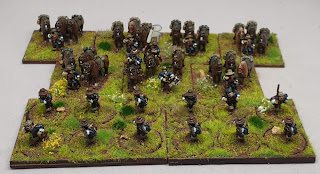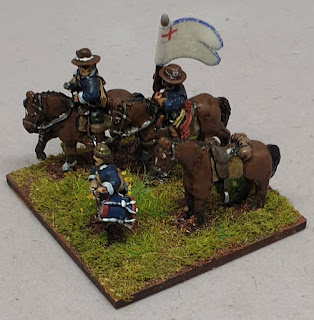Sir Henry Washington's Regiment of Dragoons
Raised in 1642 by Colonel James Ussher, Washington was Lieutenant Colonel and led the Regiment at Edgehill. He took over command when Ussher was killed, scaling the walls at Lichfield in 1643. They are also known as Prince Maurice's Dragoons as it appears that Maurice was honorary colonel.
They fought at Powick Bridge; Edgehill; were present at the Standoff at Turnham Green; stormed Marlborough; possibly a skirmish at Burford (where they over wintered as a garrison regiment); the standoff at Cirencester; stormed Cirencester and Birmingham, before taking part in the siege of Lichfield, where Ussher fell.
As Washington's Dragoons they fought at Caversham Bridge; Chinnor; Chalgrove Field; the storm of Bristol; the siege of Gloucester before garrisoning Banbury and Evesham. From there they marched north with Rupert probably firing the only shots fired at the storm of Stockport; and most probably Marston Moor - whilst there is no specific mention of Washington’s at Marston Moor, there were definitely Royalist dragoons at the battle and there is no other obvious candidate for the dragoon standard captured see below (logic would also suggest that they took part in the many engagements that took place as Rupert marched North). They followed this up with a skirmish at Montgomery, the battle of Montgomery Castle, before marching to Chester to join their garrison. They spent most of the 1644/5 winter in Chester before venturing out to fight at Christleton; returned to be besieged at Chester; marched out of Chester by Maurice and Rupert they stormed Ledbury, joined the Worcester garrison before possibly skirmishing at Abberley.
They finished the First Civil War in Worcester where they were besieged, ultimately surrendering in July 1646.
As the Regiment was part of the Oxford Army in 1643 it is highly likely that they were recipients of Thomas Bushell's issue of all red, or all blue suits. I've gone for dark blue suits.
There are three guidons recorded that Washington's Dragoons are prime candidates for ownership, although nothing is certain. When Essex relieved Gloucester his army captured two dragoon guidons which have both been linked to Washington's: both are white with blue and white fringing, one is plain bar a cross of St George canton, the other identical except for a red piles wavy. I have chosen to use the plain white guidon, which would appear to be a lieutenant colonel's colour. The guidon captured at Marston Moor is also white with a blue and white fringe, this bears "a roundhead face, and on its top the letter P. (which is conceived to signifie a Puritan) with a sword in a hand reaching from a cloud, with this mott, FIAT IUSTITIA".(A Full Relation of the Late Victory)
Washington distinguished himself at Edgehill and Bristol, and although he received no knighthood in recognition; he would later inherit his father’s title. He was made governor of the vital City of Worcester in 1645 which he refused to surrender to the Scots.
A known royalist, he was kept under close surveillance throughout the interregnum. With the Restoration he was made Major of the King’s Foot Guards, dying in 1664 aged 49. He is buried at St Mary Magdalene Church, Paradise Road, Richmond TW9 1SN.
The Regiment are re-enacted by Prince Maurice's Dragoones.
His cousin, John, emigrated to the British Colony of Virginia; his grandson, George, you might just have heard of...
They finished the First Civil War in Worcester where they were besieged, ultimately surrendering in July 1646.
As the Regiment was part of the Oxford Army in 1643 it is highly likely that they were recipients of Thomas Bushell's issue of all red, or all blue suits. I've gone for dark blue suits.
There are three guidons recorded that Washington's Dragoons are prime candidates for ownership, although nothing is certain. When Essex relieved Gloucester his army captured two dragoon guidons which have both been linked to Washington's: both are white with blue and white fringing, one is plain bar a cross of St George canton, the other identical except for a red piles wavy. I have chosen to use the plain white guidon, which would appear to be a lieutenant colonel's colour. The guidon captured at Marston Moor is also white with a blue and white fringe, this bears "a roundhead face, and on its top the letter P. (which is conceived to signifie a Puritan) with a sword in a hand reaching from a cloud, with this mott, FIAT IUSTITIA".(A Full Relation of the Late Victory)
Washington distinguished himself at Edgehill and Bristol, and although he received no knighthood in recognition; he would later inherit his father’s title. He was made governor of the vital City of Worcester in 1645 which he refused to surrender to the Scots.
A known royalist, he was kept under close surveillance throughout the interregnum. With the Restoration he was made Major of the King’s Foot Guards, dying in 1664 aged 49. He is buried at St Mary Magdalene Church, Paradise Road, Richmond TW9 1SN.
The Regiment are re-enacted by Prince Maurice's Dragoones.
His cousin, John, emigrated to the British Colony of Virginia; his grandson, George, you might just have heard of...
Brushwork by Alan Tuckey, basing by my own fair hand.
If you enjoyed reading this, or any of the other posts, please consider supporting the blog.
Thanks.













"...his grandson, George, you might just have heard of..."
ReplyDeleteLol, I had no idea!
Superb, great job on these lovely units!
ReplyDeleteThanks
ReplyDelete